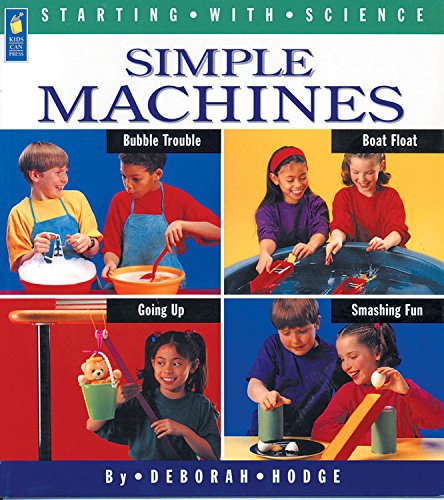-
What's Inside You?
Susan Meredith
Paperback (Usborne Pub Ltd, Dec. 1, 2006)Provides information about the human body, with sections on eating, breathing, blood, skin, senses, the brain, muscles, and the cells that make up the body. N
N
-
Solids, Liquids and Gases
Ontario Science Centre, Ray Boudreau
Paperback (Kids Can Press, Aug. 12, 1995)Solids, Liquids and Gases has 13 experiments carefully chosen by the Ontario Science Centre. With minimal supervision, children can explore the three states of matter, what makes each state unique and how matter changes from a solid to a liquid to a gas through evaporation, condensation, melting and freezing. Filled with bright photographs, the Starting with Science series provides valuable lessons about basic science for five to eight year olds. M
M
-
Simple Machines
Deborah Hodge, Ray Boudreau
Paperback (Kids Can Press, Jan. 1, 1998)Thirteen experiments about the six simple machines -- the lever, wheel and axle, pulley, inclined plane, wedge and screw -- teach kids about basic science. Full-color photographs and step-by-step instructions clearly explain each activity, so that kids can make the most of the machines with minimal help from adults. Part of the Starting with Science series, Simple Machines encourages children to have fun as they learn basic science and fills a need for primary-level science resources. K
K
-
Why Do Tigers Have Stripes?
Helen Edom, Robert Morton
Paperback (Usborne Pub Ltd, June 1, 2006)Explains how skin and fur colors and patterns help animals escape predators, hunt prey, and find a mate. P
P
-
What's Under the Sea
Sophy Tahta, Stuart Trotter
Paperback (Usborne Pub Ltd, June 1, 2006)Introduces the oceans of the world, providing information on fish, coral reefs, polar seas, divers, underwater vessels, the seabed, oil drilling, and the use and abuse of the oceans. K
K
-
Why Do People Eat
Kate Needham, Annabel Spenceley, Kuo Kang Chen, Lindy Dark, Non Figg
Paperback (Usborne Pub Ltd, Dec. 1, 2006)Using simple text and illustrations, explains why people need food, where food comes from, and how the body uses it. N
N
-
Bubbles Float, Bubbles Pop
Mark Andrew Weakland
Paperback (Capstone Press, Feb. 1, 2011)What makes a bubble float? Are the bubbles in your soda the same as the bubbles in your tub? What makes a bubble pop? Discover the wonder and science of bubbles in Bubbles Float, Bubbles Pop. M
M
-
Magnets Push, Magnets Pull
Mark Andrew Weakland
Paperback (Capstone Press, Feb. 1, 2011)Can a magnet really crush a car? How do magnets stick to the fridge without tape or glue? Discover the wonder and science of magnets in Magnets Push, Magnets Pull. O
O
-
Starting Point Science
Susan Mayes, Richard Deverell, Mike Pringle
Hardcover (Usborne Pub Ltd, July 1, 2002)STARTING POINT SCIENCE, VOLUME 1 W
W
-
What Makes You Ill
Mike Unwin, Kate Woodward, Annabel Spenceley, Kuo Kang Chen, Non Figg
Paperback (Usborne Pub Ltd, Dec. 1, 2006)Introduces various types of illness and their causes and discusses germs, allergies, accidents, preventing disease, and healthy living. K
K
-
Plants
Ontario Science Centre, Ray Boudreau
Paperback (Kids Can Press, Jan. 1, 1998)Why do potatoes have eyes? Can a garden grow without dirt? What's that blue stuff that grows on bread? Children ask a lot of questions about the world and what it's made of. Plants contains 13 carefully chosen experiments from the Ontario Science Centre. With minimal supervision, children explore how plants grow and why they need water, sunlight and soil. The Starting with Science series combines easy-to-do experiments with easy-to-understand explanations. K
K
-
Simple Machines
Deborah Hodge, Ray Boudreau
Hardcover (Kids Can Press, June 30, 1996)Thirteen experiments about the six simple machines -- the lever, wheel and axle, pulley, inclined plane, wedge and screw -- teach kids about basic science. Full-color photographs and step-by-step instructions clearly explain each activity, so that kids can make the most of the machines with minimal help from adults. Part of the Starting with Science series, Simple Machines encourages children to have fun as they learn basic science and fills a need for primary-level science resources. O
O